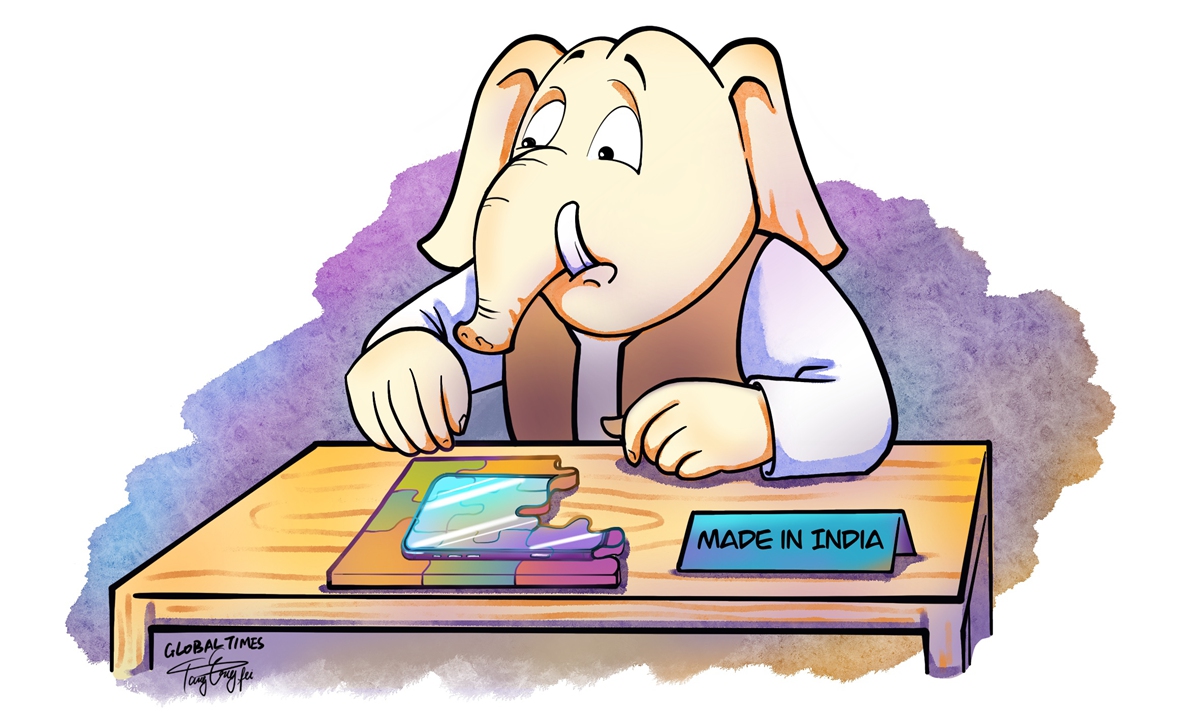
Illustration: Tang Tengfei/Global Times
Should restrictions on Chinese investment be relaxed immediately to boost export levels? Since the Indian Ministry of Finance recently released the Economic Survey for 2023-24 calling for the introduction of Chinese investment and the improvement of China-India relations, this topic has sparked intense debate within India. As the debate continues to escalate, there are also rumors that the Indian government is considering relaxing restrictions on Chinese investment and visa restrictions for Chinese citizens. This confirms a fundamental fact: The "Asia's strictest curbs on Chinese business" have indeed hindered India's industrial upgrading. It also indicates that more and more people in India are beginning to face up to this reality.
In 2020 New Delhi adopted a series of measures to obstruct normal economic and trade exchanges between the two countries under the guise of protecting domestic industries. These measures included strictly limiting the issuance of visas to Chinese citizens, banning hundreds of Chinese mobile applications, delaying the approval of Chinese investments, and reducing and even halting direct flights between the two countries. However, four years later, these measures have not achieved any results and are widely believed to have "undermined Modi's ambitions to make India a factory hub." In 2023, the share of manufacturing in India's GDP fell from 16 percent in 2015 to around 13 percent, far below the Modi government's target of 25 percent, a goal that has been postponed three times to 2025. Once again, it has been proven that decoupling does not lead to prosperity, and such extreme policies have essentially reached an impasse.
The development of India's manufacturing industry requires Chinese components, intermediate goods, and technical support. It is not realistic to bypass China. In recent years, the fastest-growing segment of China-India trade has been electronic products, presenting a great opportunity for India which is eager to expand and strengthen its manufacturing sector. However, a large number of skilled Chinese professionals have been kept out of the country due to visa restrictions. From footwear and textiles to engineering and electronics, Indian businesses have purchased machines from China but cannot use them productively without the help of Chinese technicians. The machines are lying idle, and export orders unfulfilled. Many Indian companies are eagerly waiting for the government to relax visa restrictions with China and resume direct flights between the two countries to boost their orders. It is evident who has been harmed by New Delhi's reckless moves.
In fact, over the past four years, the most vehement opposition to those policies has come from the very groups that New Delhi is trying to "protect." Some Indian media outlets have reported that in the past four years, Indian electronics manufacturers have suffered $15 billion in production losses and 100,000 job cuts due to escalating tensions with China. Indian business leaders and some scholars believe that India has almost missed out on the opportunities brought by the global industrial chain adjustment, as "the world is not waiting for India." The latest report from the Indian Ministry of Finance is actually a concentrated presentation of such voices, and it is worth the attention of the Indian policymakers.
The latest to speak out is the Indian Commerce and Industry Minister Piyush Goyal, who stated on July 30 that India is not re-thinking the issue of allowing Chinese investments into the country. This statement is regrettable and shows the wavering and division within the Indian government. Some Indian elites deeply rooted in their hostility toward China, interest groups, and Western lobbyists will continue to influence decision-making in New Delhi, but this does not change the fact that choosing to cooperate with China will benefit India's development. As the Global Times stated in a previous editorial, by continuing to refuse visas and resist resuming direct flights, India risks losing Chinese business and tourism to other destinations. New Delhi should do the correct math.
At the same time, we also noticed that many Western media outlets are closely watching the direction of India's policy toward China, trying to steer economic and trade issues toward geopolitical directions. Some American media outlets have openly stated that the Indian government's approach to Chinese investment must consider broader geopolitical implications, especially India's relationship with the US and other strategic partners, and reminded India to ensure that its economic interests are aligned with its strategic goals. This is actually telling India to follow America's lead. India, which places great emphasis on independent diplomacy, needs to be vigilant against such rhetoric.
The China-India relationship has important implications beyond bilateral relations. As two neighboring major developing countries and emerging economies, both countries should have the wisdom and capability to achieve peaceful coexistence and mutually beneficial cooperation, setting an example for other "Global South" countries. We urge New Delhi to face up to the growing domestic voices with a more positive and open attitude toward bilateral cooperation in the economic and trade fields. New Delhi should know that a timely correction of wrong policies will not lead it to "lose face," but will demonstrate India's maturity and confidence.




